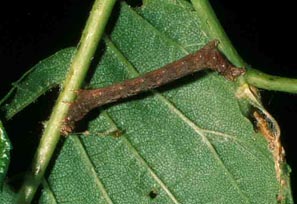Cankerworms | |
|---|---|
| April 15, 2008 | |
|
Spring and fall cankerworms are active at this time of year throughout the state. They were historically most common on American elm; but with the loss of that tree in most areas due to Dutch elm disease, they are now most commonly found as a pest on other elms, hackberry, honey locust, and crabapple.  There are two species of cankerworm. Fall cankerworm emerges as adult moths in late fall, typically being the last moths to be seen before winter. Spring cankerworm emerges as adult moths in the late winter to early spring, typically being the first moths of the coming growing season. In both species, the male moths have wings and fly up into the trees to mate with the females. The females are wingless moths that emerge from the soil like the males but have to crawl up the tree. Eggs are laid on the branches of the tree, with both speciesí eggs hatching at bud break of the host tree.v The eggs hatch into caterpillars that have fewer prolegs, larval legs, than other caterpillars. As a result, it is more effective for them to move by grasping with the three pairs of true legs at the front of the body and then swinging up the back end of the body just behind them where the two to two-and-one-half pairs of prolegs grasp the surface. Then the front legs release, with the front of the body swinging forward to grasp at full extension. This process causes a loop to form and reform, resulting in these insects being called loopers or inchworms. The loopers form a family of moths with many species, so most loopers seen are not cankerworms. Cankerworm larvae are green or brown, and grow to be about 1 inch long later in the spring. At that time, they drop from the trees on silk strands to the soil to pupate. They spend the rest of the summer there, emerging as moths in late fall or late winter, depending on the species. Damage from cankerworms may not be obvious, as they commonly eat the tree foliage as it emerges. What appears as delayed leaf emergence on trees may in fact be caused by cankerworms. Emerged leaves will have leaf margins eaten, frequently to the midvein. Scouting is simple for cankerworms, as sharply striking the branch will dislodge the caterpillars, resulting in their hanging off of the branch on strands of silk, where they can easily be seen. Cankerworms are typically not a threat to the health of the tree, although their foliage removal can cause severe aesthetic injury. Control cankerworms at this time of year with application with acephate (Orthene), azadirachtin (Azatin, Neem), Bacillus thuringiensis kurstaki (Dipel, Thuricide), carbaryl (Sevin), or spinosad (Conserve). Other labeled insecticides will also be effective. | |
| Author: | Phil Nixon |
